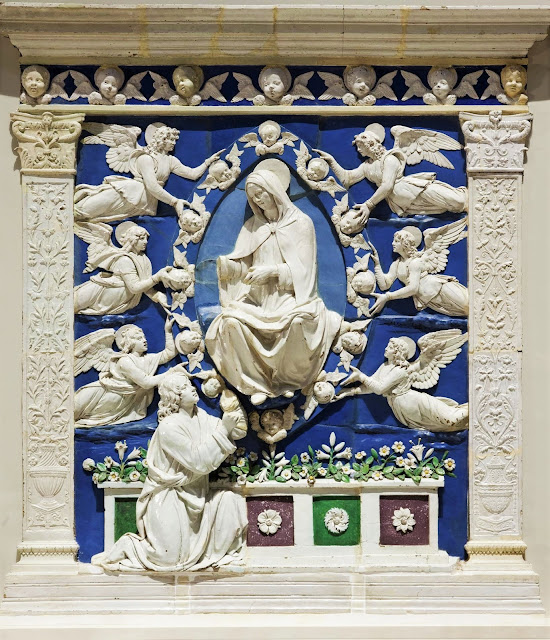 |
| +Bernardo Daddi and Workshop, The Virgin Dropping Her Belt to Saint Thomas Italian, c. 1337-1339 New York, Metropolitan Museum of Art, Robert Lehman Collection |
In this legend, Saint Thomas was late in joining the other Apostles at Mary's deathbed. You will remember that Thomas was the one who missed the appearance of the Risen Christ to the Apostles and refused to believe in the reality of the Resurrection until he had seen and touched the Risen Christ, Possibly, like many of us, he had time management issues!
 |
| Donato and Gregoria d'Arezzo, The Incident of the Girdle Italian, c. 1315-1325 Viterbo, Santa Maria Maggiore |
,%20c.%201316-1331_New%20York,%20Pierpont%20Morgan_MS%20G%2050,%20fol.162v.jpg) |
| Saint Thomas Receives the Virgin's Belt From the De Lisle Hours English (possibly York), c. 1316-1331 New York, Pierpont Morgan Library MS G 50, 162v |
 |
| +Saint Thomas Receives the Virgin's Belt English, c. 1325-1350 Beckley, Oxfordshire, Church of the Assumption of Saint Mary the Virgin |
Whatever his reason, Thomas missed the death and funeral of Mary. Apparently, it was his request to see her again that caused her tomb to be opened. Its flower-filled, but bodyless interior revealed the Assumption. Again he refused to believe without proof. So, Mary appeared to him, removed the belt (sometimes called a girdle) she wore around her waist and dropped it to him from heaven. This putative relic is kept in the Cathedral of Prato, where it is solemnly displayed five times a year.
 |
| +Maso di Banco, Saint Thomas Receives the Virgin's Girdle Italian, c. 1337-1339 Berlin, Gemäldegalerie der Staatliche Museen zu Berliln |
 |
| +Bartolomeo Bulgarini, Saint Thomas Receives the Virgin's Belt Italian, c. 1360s Siena, Pinacoteca Nazionale |
 |
| Saint Thomas Receives the Virgin's Belt Cutting from a Choir Book Italian (Lombardy), c. 1400-1425 London, British Museum MS Additional 38897B |
 |
| *Lorenzo di Pietro Vecchietta, The Virgin Dropping Her Belt to Saint Thomas Italian, c. 1457 Montemerano di Manciano, Church of San Giorgio |
 |
| *Pietro d'Antonio Dei, The Virgin Dropping Her Girdle to Saint Thomas Italian, c. 1470-1475 Cortona, Museo Diocesano |
This charming story provided some artists with an alternative iconographic image to use as a reference to the Assumption of the Blessed Virgin. It appears most frequently in paintings of Italian origin, though not exclusively. The greater frequency in Italian painting is probably due to the Prato tradition of displaying the belt at the cathedral.
,%20c.%201460_LA,%20Getty_MA%20Ludwig%20IX%2012,%20fol.%20268v_2.jpg) |
| +The Incident of the Girdle From a Book of Hours Italian (Naples), c. 1460 Los Angeles, J. Paul Getty Museum MA Ludwig IX 12, fol. 268v |
 |
| +Matteo di Giovanni, Saint Thomas Receives the Virgin's Girdle Italian, c. 1474 London, National Gallery |
 |
| Andrea della Robbia, Saint Thomas Receives the Virgin's Girdle Italian, c. 1485-1500 London, Victoria and Albert Museum |
 |
| +Master of the Eleven Thousand Virgins, Saint Thomas Receives the Virgin's Belt Spanish, c. 1490 Madrid, Museo Nacional del Prado |
 |
| *Girolamo di Benvenuto di Giovanni del Guasta, Saint Thomas Receiving the Virgin's Girdle Italian, c. 1500 Torita di Siena, Oratory of the Madonna della Nevi |
 |
| +Jacopo Palma the Elder, The Virgin Mary Drops Her Belt to Saint Thomas Italian, c. 1513 Venice, Gallerie dell'Accademia |
 |
| +Cola dell'Amatrice, The Miracle of the Girdle Italian, 1515 Vatican City State, Pinacoteca Vatica |
 |
| +Cristoforo Allori, Incident with the Girdle Italian, c. 1600 Cortona, Cattedrale di Santa Maria |
Although the tradition of displaying the girdle continues in Prato today,1 the image of this story appears to have died out in the iconographic tradition during the sixteenth century.
1. See the website for the diocese of Prato at http://www.diocesiprato.it/pagina_template.asp?id=33&page_id=512&id_pagina=512
M. Duffy, 2020. Select images updated and new images added 2024.
+Indicates an updated image
*Indicates a new image.

,%20c.%201450-1475_Chicago,%20Art%20Institute_2.jpg)

No comments:
Post a Comment